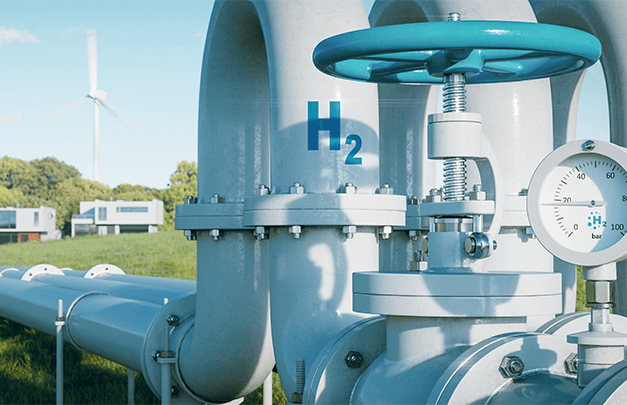The market for clean hydrogen energy is growing rapidly — the global demand for clean hydrogen grew by almost 5% in 2023, and this rate of growth is expected to continue through the next decade. The push for the development of clean hydrogen in the U.S. is being bolstered by the Biden Administration’s recent $7 billion initiative to support the production of this “green” energy source.
Part of what makes hydrogen a more eco-friendly energy source is that it’s produced using carbon capture technology to reduce harmful emissions in a wide variety of industrial and manufacturing contexts. The right industrial infrastructure can help energy producers capitalize on the growth of the clean hydrogen market, but the question is: what does the ideal pump for producing clean hydrogen energy look like?
There are a handful of features plant operators need to consider when choosing the right pump for optimizing the production of clean hydrogen energy. This guide will help operators understand what to look for in choosing the ideal pump for the production of this kind of hydrogen energy.
What are the three types of hydrogen energy?
Hydrogen can be used to produce energy in a variety of ways, but not all methods of producing hydrogen energy are created equal. While some types of hydrogen energy production yields a final product that is more green or eco-friendly, other types of hydrogen energy production still produce high levels of carbon emissions.
The three types of clean hydrogen energy include:
- Grey hydrogen, which is produced using the steam reforming of natural gas. This process splits natural gas into hydrogen and CO2, but the CO2 byproduct is extremely carbon-intensive and makes grey hydrogen energy the least environmentally friendly. This is currently the most common form of hydrogen produced in the U.S.
- Blue hydrogen, which is produced using the same process as grey hydrogen, but blue hydrogen involves using a CO2 capture and storage process (CCS) to virtually eliminate harmful emissions.
- Green hydrogen, which is produced by water electrolysis and fueled by renewable sources like wind or solar power. Green hydrogen is the ideal kind of clean energy production that can help usher in the next generation of sustainable power.
There are a handful of unique challenges in the production of green hydrogen energy. First, plant operators need the kind of leak-proof, durable pumps that can transfer a variety of hazardous liquids with a high level of precision. Plus, pumps used in the production of clean hydrogen energy must be able to operate for prolonged durations at high pressure and temperatures to produce clean energy in the most efficient way possible.
How is green hydrogen energy produced?
Green hydrogen energy is produced via the electrolysis of water. Electricity is used to split water molecules into its base elements, which include gaseous hydrogen and oxygen. The hydrogen molecules are then captured and stored for a wide variety of uses, one of which includes the production of zero-emission energy.
As a result, the entire lifecycle of green hydrogen energy has minimal environmental impact, and, with the right pump solution, it can also be a highly efficient energy production process that produces a better quality end product.
What are the ideal pump features for the production of clean hydrogen energy?
Sealless magnetic drive pumps offer a number of design and operational features that are ideal for the production of clean hydrogen energy. First, they eliminate the potential for leaks, spills, or acid runaway via a sealless design. Additionally, their secondary containment systems reduce the potential for caustic, acidic fluids to escape, and these containment systems also provide increased protection against corrosive materials damaging the internal components of your pump infrastructure.
Plus, the use of high-pressure castings and the additional heat treating of the pump’s components after welding increases the strength and reliability of sealless magnetic drive pumps to contain corrosive materials even with prolonged, continuous use.
The lack of seals also makes this kind of magnetic drive pump well-equipped for frequent, high-intensity washdowns that use powerful cleaning agents, and the simplified design and engineering with minimal moving parts reduces maintenance intervals to help maximize production uptime.
Plus, the lack of buffer systems, water cooling systems, and venting or vapor recovery devices makes sealless magnetic drive pumps faster and easier to install, thus saving you time and money.
HMD/Kontro sealless magnetic pumps help create a safe, reliable, and consistent liquid metering workflow necessary for the production of high-quality clean hydrogen energy. HMD/Kontro API sealless pumps also provide continuous digital monitoring tools to help ensure accurate, continuous pump operation via detailed performance data at every stage of the clean hydrogen production process.
Why partner with IPEC for your production of clean hydrogen energy?
IPEC has decades of experience in helping plant operators leverage custom pump solutions in a variety of applications, particularly those in harsh or uncontrolled environments. Our package solutions can also help plant operators increase productivity and reduce carbon emissions to create more sustainable processes.
Our team of maintenance technicians can also provide pump system audits, health checks, troubleshooting, and upgrades in the field of operation to help you avoid costly downtime or bottlenecks in production. Plus, our expanded warehouse offers a greater inventory of spare and component parts to help hydrogen producers get the equipment they need to unlock game-changing productivity and quality.
Contact us to learn more about finding the right pump for your hydrogen energy production.

